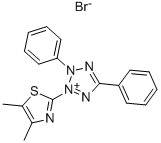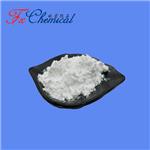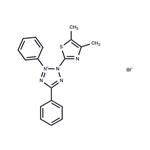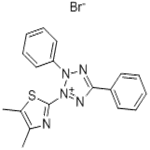Chemical Properties
Thiazolyl Blue Tetrazolium Blue (MTT) is a water soluble tetrazolium salt yielding a yellowish solution when prepared in media or salt solutions lacking phenol red. Dissolved MTT is converted to an insoluble purple formazan by cleavage of the tetrazolium ring by dehydrogenase enzymes. This water insoluble formazan can be solubilized using isopropanol or other solvents and the dissolved material is measured spectrophotometrically yielding absorbance as a function of concentration of converted dye.
Uses
Thiazolyl Blue Tetrazolium Blue (MTT) may be used in measurement of cell proliferation. MTT produces a yellowish solution that is converted to dark blue, water-insoluble MTT formazan by mitochondrial dehydrogenases of living cells. The blue crystals are solubilized with acidified isopropanol and the intensity is measured colorimetrically at 570 nm. MTT has been used as a histochemical/cytochemical reagent and for the detection of NAD. ADP-linked enzyme systems in tissue cannot be detected with MTT, due to binding of the cation by the cyanide trap used. MTT is rapidly reduced to the formazan, which chelates with nickel, copper, and cobalt; the cobalt chelate has been used in oxidative systems.
Definition
ChEBI: Thiazolyl Blue is the bromide salt of 3-(4,5-dimethylthiazol-2-yl)-2,5-diphenyltetrazolium. It has a role as a dye and a colorimetric reagent. It contains a 3-(4,5-dimethylthiazol-2-yl)-2,5-diphenyltetrazolium.
General Description
Thiazolyl Blue (MTT, Tetrazolium bromide, Methylthiazolyldiphenyl-tetrazolium bromide, Methylthialazole Tetrazolium) is a cell-permeable and positively charged colorimetric agent that is widely used to detect reductive metabolism in cells and to measure cell proliferation, cytotoxicity, and apoptosis. It is used as a direct indicator of cytotoxicity (such as for screening cancer drugs) and apoptosis. Thiazolyl Blue (MTT) is reduced from yellow color to purple formazan in living cells. As an electron acceptor, it is utilized for studying nicotinamide adenine dinucleotide phosphate (NADP)-dependent dehydrogenases.
Biochem/physiol Actions
Cell permeable: yes
Purification Methods
It is recrystallised by dissolving in MeOH containing a few drops of HBr and then adding dry Et2O to complete the crystallisation, wash the needles with Et2O and dry them in a vacuum desiccator over KOH. [Beyer & Pyl Chem Ber 87 1505 1954, Beilstein 27 III/IV 6045.]





